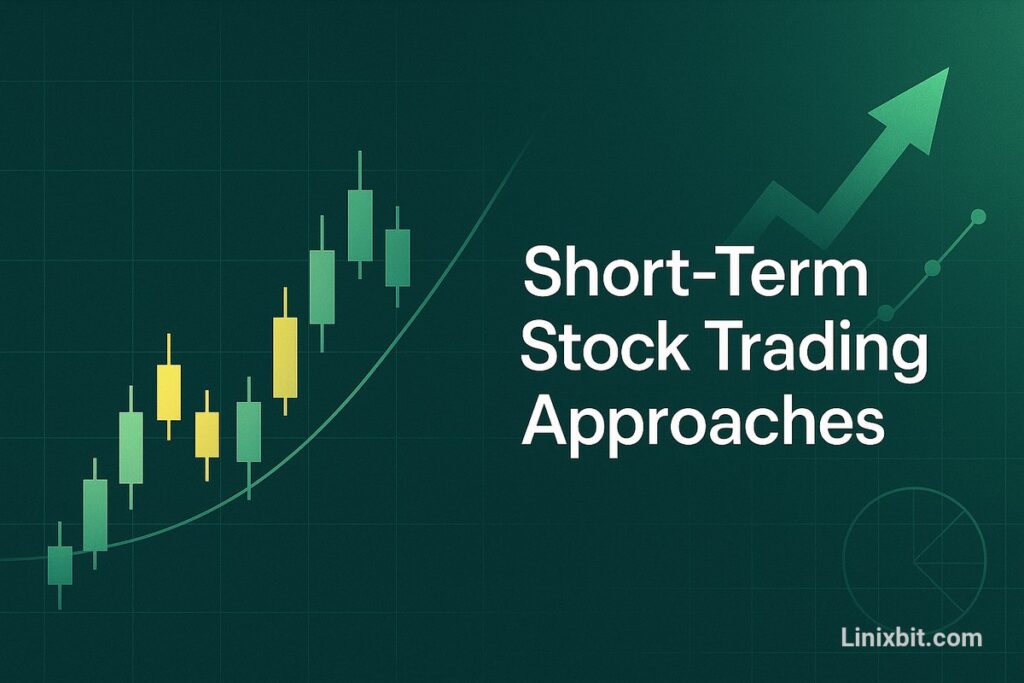The practice of trading extends beyond the simple exchange of goods or services to include securities transactions within financial markets. Investors participate in buying and selling company stocks through regulated markets during stock market trading activities. Participants use these markets to achieve their financial goals in a structured setting.
Any investor must understand the different methods available to succeed in their investments. One important question to ask to this end is, What are the different types of stock trading strategies? Structured plans known as trading strategies help traders make decisions in line with their financial objectives and investment time preferences. The following analysis examines multiple trading approaches ranging from quick scalping techniques to sustained position holding, along with the analytical instruments they rely on.
Why Choosing a Trading Strategy Matters
The selection of a trading strategy stands as the essential component to achieve personal financial goals. Specific investment strategies become essential when considering varying timeframes and risk appetites since investors need to ensure their methods directly support their unique goals. The absence of a defined strategy in traders leads to impulsive actions that create unpredictable results.
Your investment decisions need to be informed by understanding which trading strategies will suit your specific financial goals. Fintech development has provided traders with sophisticated tools and platforms that support detailed and data-backed implementation of their selected trading approaches. Traders benefit from adaptability, which allows them to manage complex market conditions successfully. Ultimately, What Are the Different Types of Stock Trading Strategies? Knowing them is key to effective market participation.
Short-Term Stock Trading Approaches
Short-term strategies target quick profits through rapid stock price fluctuations in short time frames. These trading methods need quick decision-making abilities and deep technical analysis knowledge. These trading methods require traders to achieve small profits repeatedly which accumulate with time through dedicated focus and disciplined practice.

Intraday Trading
Day trading or intraday trading requires traders to buy and sell stock positions before the market closes that same day. The main objective of this trading method involves taking advantage of small price changes while steering clear of potential overnight market dangers. Successful implementation of this trading approach requires rapid execution alongside technical analysis expertise and strong emotional regulation to handle the built-in pressures.
Intraday trading’s inherent risks make effective risk management essential. Traders use stop-loss orders to control losses while keeping position sizes small by risking only 1-2% of capital per trade and ensuring their trades maintain a positive risk-reward ratio. Maintaining discipline prevents impulsive decisions from rapidly diminishing your capital reserves.
Scalping
Scalping represents an ultra-short-term trading approach where traders extract several small profits based on minor price fluctuations that take place in seconds or minutes. Scalpers trade multiple times a day, sometimes reaching hundreds of trades per session, to build small yet regular profits. This high-frequency approach demands speed and precision.
Scalping achieves success in markets characterized by high liquidity and narrow bid-ask spreads which help reduce transaction expenses. Scalpers base their trading strategies on technical analysis and they frequently utilize Level 2 market data to understand supply and demand dynamics so they can find brief market inefficiencies. Advanced scalping strategies use automated algorithms to ensure fast execution while minimizing human emotional involvement.
Mid to Long-Term Investment Strategies

Investors use these strategies to maintain stock positions from several days up to multiple years to benefit from greater price fluctuations or sustained growth opportunities. These investment approaches need extended patience and a comprehensive market view while short-term tactics focus on quicker results. Traders choose these strategies according to their ability to tolerate extended market exposure.
Swing Trading
Swing trading combines elements of short and long-term trading by maintaining positions in stocks for periods ranging from several days to weeks. The objective of swing traders is to generate profits by recognizing and exploiting price swings within existing market trends through thorough analysis to determine their trading positions. Traders must demonstrate patience to withstand small market changes while using this strategy.
Swing traders utilize technical analysis methods which cover chart formations like Head and Shoulders or Triangles as well as indicators for analysis such as Moving Averages, RSI and MACD. The tools allow traders to predict trend reversals and continuations which influence their trading decisions. Proper risk management practices play a critical role in handling the normal market fluctuations that occur during holding periods.
Position Trading
Position trading represents a long-term investment strategy where investors hold securities for extended periods ranging from months to multiple years while concentrating on broad market trends. Position traders employ macroeconomic and fundamental analysis to gain profits through extended market trends rather than rapid price fluctuations. Effectively executing this strategy demands thorough understanding of market dynamics.
The methodology depends on fundamental analysis to assess financial performance of companies and study economic indicators and sector trends. Position traders evaluate qualitative aspects including management quality and business models in addition to numerical data. Position trading success depends on traders maintaining patience and ignoring temporary market fluctuations to target long-term asset value.
Momentum Trading
Momentum trading requires investors to either purchase or sell securities by observing their strong recent performance. Momentum traders operate under the assumption that assets which demonstrate significant upward or downward trends will sustain their movement in the same direction. The strategy works to capitalize on ongoing price trends while following existing market sentiment.
Through technical analysis tools such as moving averages, Relative Strength Index (RSI), and stochastic indicators momentum traders pinpoint assets demonstrating strong momentum. The analysis focuses solely on how prices move and the volume of trades instead of evaluating the basic economic or fundamental elements. Effective application of this approach depends on rapid response to variations in trend strength.
Delivery Trading
The conventional delivery trading method involves investors buying stocks with plans to maintain ownership beyond a single trading day extending into weeks, months or years. The strategy targets sustained financial growth and stability through the physical transfer of shares into the buyer’s Demat account.
The standard settlement cycle for delivery trading in India operates on a T+1 basis which enables shares purchased on Monday to be credited to the buyer’s account by Tuesday. This investment strategy attracts investors who are focused on growing their wealth over time through capital gains and dividends and managing their risk with diversified portfolios. The requirement to sell shares within the same trading day does not exist in this strategy which makes it safer compared to intraday trading.
Analytical Foundations: Technical vs. Fundamental Trading
Two fundamental analytical methods serve as the foundation for nearly every trading decision beyond individual strategies. The methodologies offer traders structured approaches to assess investment opportunities while emphasizing different methods of data interpretation and future market prediction.
Technical Trading (Technical Analysis)
Technical analysis uses historical price and volume information to forecast future market price changes. Technical analysts maintain that historical market data contains all existing information which helps predict future market trends. This method involves the extensive use of visual chart patterns to detect market trends and possible reversing points.
Technical analysts utilize multiple tools such as candlestick charts and chart patterns alongside indicators including moving averages and trendlines, plus oscillators like RSI. This type remains focused exclusively on statistical data related to price movements and trading volumes while ignoring intrinsic company value. The primary application of this method is for trading decisions that occur over short and medium time frames.
Fundamental Trading (Fundamental Analysis)
The process of fundamental analysis evaluates corporate financial health alongside broader economic metrics to discover a stock’s true worth. Investors who practice this strategy analyze corporate fundamentals to determine whether to purchase or sell assets based on their market valuations.
The analysis combines economic indicators like GDP and inflation with industry research and detailed financial records of companies including income statements and balance sheets and cash flow reports. Investors analyze both quantitative financial ratios including P/E and EPS ratios and qualitative factors like management expertise and brand reputation. Long-term investment decisions benefit most from fundamental analysis.
Selecting Your Ideal Stock Trading Strategy
Choosing a suitable stock market trading strategy requires one to consider their individual preferences and elements like financial targets and risk tolerance. Investment planning requires you to evaluate whether your primary goal is to achieve quick profits or to establish long-term wealth. The trading strategy you choose should correspond with how much market volatility you can handle.
Your trading strategy must be complemented by your analytical method of choice which can be technical analysis or fundamental analysis. Success requires ongoing learning and disciplined implementation of adaptive strategies. What Are the Different Types of Stock Trading Strategies? The answer lies in finding the one that best suits your unique profile.
Mastering Your Trading Journey
Stock trading features a wide range of strategies which serve various investment goals and risk tolerances. Both new and experienced investors need to understand the range of trading styles from quick intraday trading and scalping to the long-term position and delivery trading strategies. Technical and fundamental analysis form the foundational analytical tools needed to manage market complexities.
Becoming proficient in your trading journey demands more than simply identifying what are the Different types of stock trading strategies? A thorough understanding of your financial objectives together with a dedication to continuous learning and rigorous risk management forms the foundation for successful trading. When you choose stock trading strategies that suit your personal attributes and apply them with dedication you will trade in the stock market with enhanced confidence and make better financial decisions that lead you towards your financial goals.


